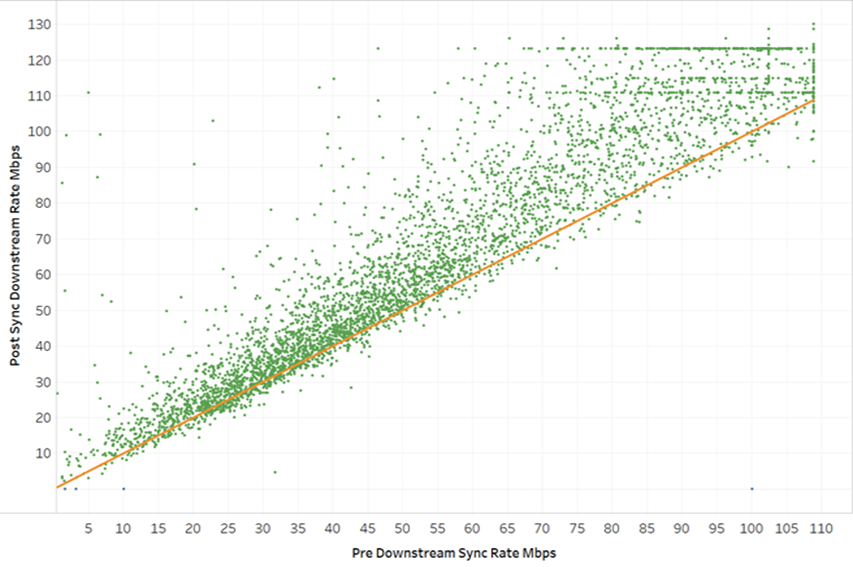Vectoring rollout to increase speed and stability of VDSL
Last September we announced our intention to install VDSL Vectoring in areas where fibre isn’t planned as part of our copper network’s lifecycle management. Vectoring is a VDSL enhancement that increases the speed and stability of a connection.
There are two groups of customers who can benefit from this upgrade;
- Existing VDSL customers in vectored areas most of which will get an instant upgrade and
- Existing ADSL customers who can upgrade to the faster more stable vectored VDSL connection.
We have now undertaken two separate trials on over 8,000 VDSL lines to confirm expected speed and stability gains while ensuring the minimisation of end user impact. As a result of these successful trials we are now planning to deploy in the second half of May.
What’s changing
Vectoring will be applied to every VDSL-enabled port in cabinet areas where we don’t have plans to lay fibre as our roll out proceeds. If your customers have a vectoring compatible modem they’ll receive a much greater downstream synch rate. The new cards will also improve noise performance.
Supporting details
Vectoring reduces the impact of cross talk and interference on copper cables. It enables better performance from a VDSL line, with your customers seeing higher line speeds and greater stability. This improvement requires the customers to have a compatible modem. We believe the majority of modems are at least partially compatible, based on our lab tests. A fully compatible modem sees a downstream speed improvement, while a partially compatible or incompatible modem sees no change.
We’ll also introduce G.INP to VDSL to improve electrical noise performance. This reduces the impact of impulse noise like switching transients and electric fences. Trials indicated that impulse noise becomes a bigger issue with cross-talk reduction and as a result we have set a minimum interleaving value of 4ms which will only affect modems that do not support G.INP.
There were some issues with migration identified in Trial 1 which were successfully addressed and tested in second trial through a change to the migration script and methodology:
- Modems incorrectly reporting they are vectoring compatible were detected and moved automatically into a legacy group where they receive ‘normal’ VDSL service.
- Vectoring modems that do not support G.INP and are therefore affected by impulse noise once vectoring applied were protected by a minimum interleaving setting of 4ms.
- Setting maximum speeds to 120 / 30Mbps to overcome DSLAM limitation has seen a good average improvement in downstream speed.
Most lines in Trial 2 saw some increase in downstream speed with the average moving from 56.8 to 67Mbps, an increase of 10.2Mbps or 18%

As expected a number of lines saw a decrease in upstream speed with the majority that previously had an upstream speed less than 30Mbps, seeing an average 1.9Mbps increase in upstream speed (14%). This group also saw an average 8.5 Mbps increase in downstream speed (20%). The remaining lines that previously had an upstream speed greater than 30Mbps, saw an average 9.5Mbps decrease in upstream speed (24%). This group saw an average 14Mbps increase in downstream speed (15%).
For RSPs with VDSL vectoring capable modems unable to support synch speeds greater than 100Mbps without performance degradation, Chorus can detect these modems based on model and move them automatically into a ddDLM group where they receive a limited to 100Mbps VDSL service.
This change and the trials are being discussed at a Telecommunications Forum (TCF) working group.
For more information on VDSL vectoring check out this white paper and these FAQs.
Next steps
Chorus believes that the low fault rate plus demonstrated performance improvements mean we should roll-out VDSL vectoring to all vectoring capable lines as soon as possible and are planning, subject to industry approval to do that late May.
We’re consulting with the industry, via the TCF, on the implementation of VDSL vectoring and G.INP.
Please contact your service delivery manager (or your TCF representative) if you have any further queries or have a VDSL vectoring capable modem that does support speeds greater than 100Mbps.
